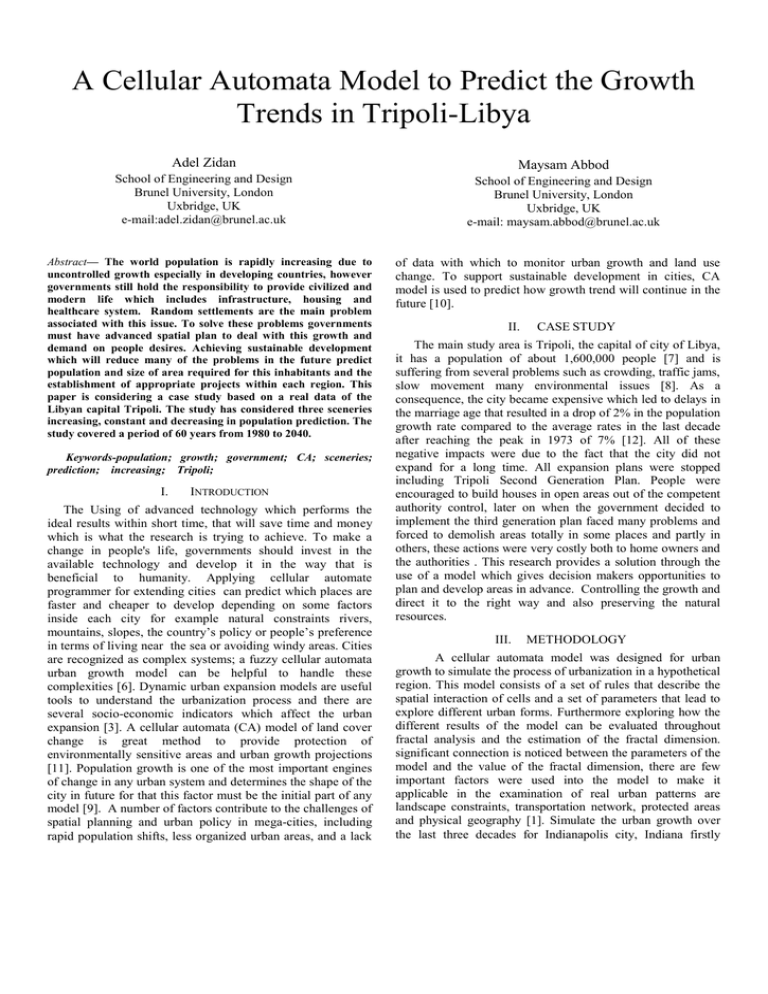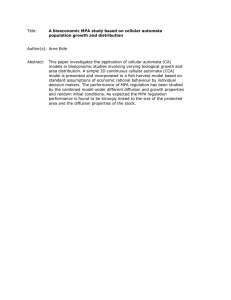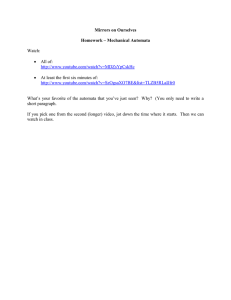A Cellular Automata Model to Predict the Growth Trends in Tripoli-Libya
advertisement

A Cellular Automata Model to Predict the Growth Trends in Tripoli-Libya Adel Zidan Maysam Abbod School of Engineering and Design Brunel University, London Uxbridge, UK e-mail:adel.zidan@brunel.ac.uk School of Engineering and Design Brunel University, London Uxbridge, UK e-mail: maysam.abbod@brunel.ac.uk Abstract— The world population is rapidly increasing due to uncontrolled growth especially in developing countries, however governments still hold the responsibility to provide civilized and modern life which includes infrastructure, housing and healthcare system. Random settlements are the main problem associated with this issue. To solve these problems governments must have advanced spatial plan to deal with this growth and demand on people desires. Achieving sustainable development which will reduce many of the problems in the future predict population and size of area required for this inhabitants and the establishment of appropriate projects within each region. This paper is considering a case study based on a real data of the Libyan capital Tripoli. The study has considered three sceneries increasing, constant and decreasing in population prediction. The study covered a period of 60 years from 1980 to 2040. Keywords-population; growth; government; CA; sceneries; prediction; increasing; Tripoli; I. INTRODUCTION The Using of advanced technology which performs the ideal results within short time, that will save time and money which is what the research is trying to achieve. To make a change in people's life, governments should invest in the available technology and develop it in the way that is beneficial to humanity. Applying cellular automate programmer for extending cities can predict which places are faster and cheaper to develop depending on some factors inside each city for example natural constraints rivers, mountains, slopes, the country’s policy or people’s preference in terms of living near the sea or avoiding windy areas. Cities are recognized as complex systems; a fuzzy cellular automata urban growth model can be helpful to handle these complexities [6]. Dynamic urban expansion models are useful tools to understand the urbanization process and there are several socio-economic indicators which affect the urban expansion [3]. A cellular automata (CA) model of land cover change is great method to provide protection of environmentally sensitive areas and urban growth projections [11]. Population growth is one of the most important engines of change in any urban system and determines the shape of the city in future for that this factor must be the initial part of any model [9]. A number of factors contribute to the challenges of spatial planning and urban policy in mega-cities, including rapid population shifts, less organized urban areas, and a lack of data with which to monitor urban growth and land use change. To support sustainable development in cities, CA model is used to predict how growth trend will continue in the future [10]. II. CASE STUDY The main study area is Tripoli, the capital of city of Libya, it has a population of about 1,600,000 people [7] and is suffering from several problems such as crowding, traffic jams, slow movement many environmental issues [8]. As a consequence, the city became expensive which led to delays in the marriage age that resulted in a drop of 2% in the population growth rate compared to the average rates in the last decade after reaching the peak in 1973 of 7% [12]. All of these negative impacts were due to the fact that the city did not expand for a long time. All expansion plans were stopped including Tripoli Second Generation Plan. People were encouraged to build houses in open areas out of the competent authority control, later on when the government decided to implement the third generation plan faced many problems and forced to demolish areas totally in some places and partly in others, these actions were very costly both to home owners and the authorities . This research provides a solution through the use of a model which gives decision makers opportunities to plan and develop areas in advance. Controlling the growth and direct it to the right way and also preserving the natural resources. III. METHODOLOGY A cellular automata model was designed for urban growth to simulate the process of urbanization in a hypothetical region. This model consists of a set of rules that describe the spatial interaction of cells and a set of parameters that lead to explore different urban forms. Furthermore exploring how the different results of the model can be evaluated throughout fractal analysis and the estimation of the fractal dimension. significant connection is noticed between the parameters of the model and the value of the fractal dimension, there are few important factors were used into the model to make it applicable in the examination of real urban patterns are landscape constraints, transportation network, protected areas and physical geography [1]. Simulate the urban growth over the last three decades for Indianapolis city, Indiana firstly Urban growth simulation for an artificial city has been done. Urban sprawl determinants such as the size and shape of neighbourhood besides examine different types of constraints on urban growth simulation were assessed. The results were showing that circular type neighbourhood are easer but faster urban growth as compared to nine-cell neighbourhood as well as the definition of CA rules is critical phase in simulating the urban growth pattern in close behaviour to existing growth. Then includes running the developed CA simulation over classified remote sensor historical image in developed GIS tool. A set of crisp rules are defined and calibrated based on real urban growth pattern. To tasting the accuracy of the simulated results as compared to the historical ground truth images examination is performed. Were obtained encouraging results and the percentage of accuracy was excellent, reaching an average accuracy of more than 80% with the need to amend CA growth rules over time to go with the growth pattern changes to achieve accurate simulation [2]. The implementation of Cellular Automata model in France. In France, the management of urban growth depends upon the housing policies that are designed by municipalities by the department of region or the state. Like many parts of the world, sustainable development in urban areas is crucial. In order to manage these problems, the urban planners use varieties of tools as conceptual models, like computer aided drafting and geographic information system. As these are traditional tools and have lost their efficiency, new strategies have been developed by researchers. Cellular Automata is an effective tool to improve explanation and forecasting of urban growth and its outcomes on the population. This is the model that describes heterogeneity of the produced results and envisages an interesting debate regarding growth management and territorial intelligence [4]. A model was designed using Fuzzy Cellular Automata (FCA) in MATLAB after digitizing land use map type to a city that can be done by giving numbers to the different areas on the map, each area indicating particular sector for instance residential area, industrial area and agricultural area etc. Also there is open area surround the existing city out of the built zones, this area is able to develop which is mean the area will become either new residential or new industrial area depending on the old area nearby and will stay as it is if it located far of the existing residential or industrial areas, also the time needed to be develop depending on its location how far from the old area. Parameter has been used which determines whether there is chance to expand in the open area or no, this parameter was giving the result in initial model from 1980 to 2010 and the same parameter is used in prediction model. To compare the previous growth in the past years, old maps were digitized to identify any changes between the past and present growth. The model presents the areas as cells and allows some areas to grow (residential and industrial) if they have a chance to do so (open area nearby) and other areas (public facilities, business, sports and leisure areas) will be added to the final map as public services area (20% to 25% of total area).In the prediction model, the fuzzy logic file consist of two inputs were used, population and area inputs and nine rules made into it. The outputs are five which are (small (S), small-medium (SM), medium (M), medium-high (MH) and high (H)) TABLE 1. FUZZY LOGIC MEMBERSHIP RULES. Population Area Small Medium High Small Medium High S SM M IV. SM M MH M MH H RESULTS A. Initial Model This model designed to test the period from 1980 to 2010 and it has resulted in a land size of 615 km2 and population 1,600,000 which is consistent with the official governmental [5], the population growth rates for the 30 years have been used into the model(colours indicating different type of area for example residential, industrial. etc). Figure 1. Tripoli land use map in 1980. Figure 2. Digitized Tripoli Land Use Map of 1980. Figure 3. Tripoli Land Use Map of 1980 by Model. Figure 4. Tripoli land use map of 2010. B. Prediction Model This model was designed for the next 30 years from 2010 to 2040 using fuzzy logic file with two inputs (population and area) has been used to obtain accurate results. Additionally the model was made of three sceneries decreasing, constant, and increasing in population growth prediction. The growth rate at 2% presumed as constant scenario for the reason that the average growth rates for the period between 2000 to 2010 were 2% whereas the increasing scenario represents a growth rate of 0.2% every ten years and finally the decreasing scenario represents a minus growth of 0.2% every ten years. The three sceneries have provided almost the same results with predictive calculation. 𝑃2020 = 𝑃2010 × (1 + 𝑖)n (1) Figure 5. Digitizing map of 2010. n 𝑃2030 = 𝑃2020 × (1 + 𝑖) (2) 𝑃2040 = 𝑃2030 × (1 + 𝑖)n (3) where i is the growth rate, n is number of years. Year 1980 1995 2000 2010 2020 2030 2040 1) Declining Growth Scenario In this scenario the growth rate is -0,2% every ten years and the prediction are 832km2 total area and 2,163,300 population. TABLE 2. POPULATION PREDICTION. Decreasing Constant Increasing 784,000 784,000 784,000 997,000 997,000 997,000 1,100,000 1,100,000 1,100,000 1,600,000 1,600,000 1,600,000 1,912,500 1,950,400 1,989,000 2,241,500 2,377,500 2,521,300 2,575,800 2,898,200 3,259,100 Figure 6. Expanded map on 2040 based on declining growth scenario. Figure 7. Total area using declining growth scenario. Figure 8. Population prediction based on the declining growth scenario. Figure 10. Total area based on fixed growth scenario. Figure 11. Population prediction based on fixed growth scenario. 2) Fixed Growth Scenario 3) Increasing Growth Scenario The population growth rate is fixed in this scenario with 2% for the thirty years, the gained results is 1,109 km2 area and 2,885,900 population which almost equal the predictive calculation of the population prediction. In this case the growth rate goes up by 0,2% every decade, the results are 1,150km2 area and 3,002,900 population. Figure 12. Expanded map on 2040 based on increasing growth scenario. Figure 9. Expanded map on 2040 based on fixed growth scenario. authorities the potential to plan ahead in advance to control the expansion and avert the troubles of unplanned growth. The model results are similar to predictive calculation that gives evidence the model is reliable. The Libyan urban planning agency is therefore encouraged to use this model so that expansion of cities can be based on factual data and which will to an improvement in the quality of life of citizens. ACKNOWLEDGMENT I would like to thank the Libyan government for the financial support. REFERENCES 1. Figure 13. Total area based on increasing growth scenario. Figure 14. Population prediction based on increasing growth scenario. V. CONCLUSIONS The study showed the importance of using the CA model for future urban planning. This model provides to authorities with easy, efficient and accurate methods for planning based on actual population growth rates. It also provides the L, Apostolos, Urban Growth Simulation Through Cellular Automata: A Way to Explore the Fractal Nature of Cities, Science Regional, 2010. 2. S. Alkheder, J. Shan, Cellular Automata urban growth simulation and evaluation-A case study of Indianapolis, Proceedings of the 8th International Conference on Geo Computation. 1-19, 2005. 3. D. Wu, J. Liu, S. Wang, Simulating urban expansion by coupling a stochastic cellular automat a model and socioeconomic indicators. 24, 235-245, 2010. 4. P. Antoni, P. Frankhauser, C. Tannier, S. Youssoufi, Modelling Urbanization to Simulate Prospective Scenarios, Territorial Intelligence and Governance Participatory action-research and Territorial Development, 14-58. 2012. 5. A. Alshrief, Population, education and manpower in Libya Dar Alketab Benghazi Libya, 2010. 6. K. Al-Ahmadi, A. Heppenstall, L. Hogg, Modeling urban growth dynamics using cellular automata and GIS. 2010. 7. Urban Planning Agency. Regional Development Plan. Tripoli Region, 2007. 8. Urban Planning Agency 2nd Generation Plan Evaluation. Tripoli Region, 2007. 9. A. Mavroud, Simulating city growth by using the Cellular Automata Algorithm MSc AAC, 2007. 10. H. Shafizadeh, M. Helbich, Spatiotemporal urbanization processes in the megacity of Mumbai, India: A Markov chains-cellular automata urban growth model. 40, 140-149, 2013. 11. D. Mitsova, W. Shuster, X. Wang, A cellular automata model of land cover change to integrate urban growth with open space conservation. 0169-2046, 2010. 12. The World Bank. Libyan population growth 1960 – 2012[online] available at http://data.worldbank.org/ [accessed on 21/11/2012].



